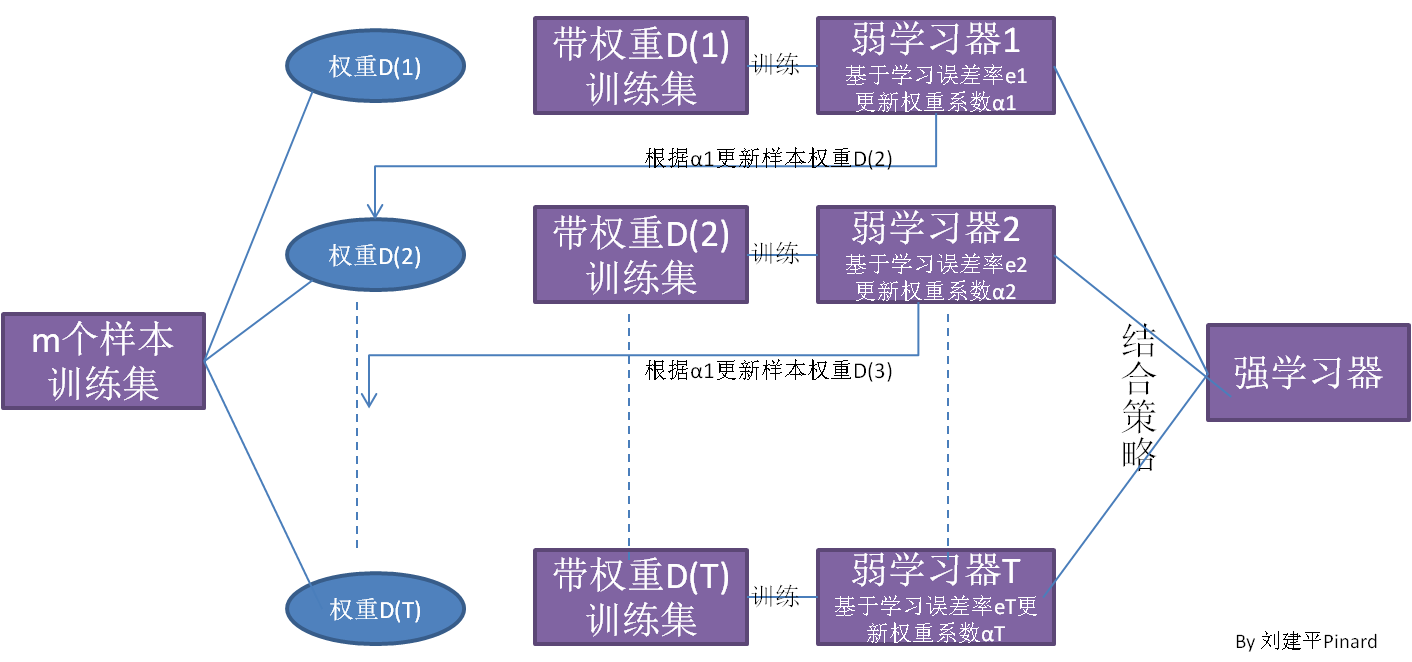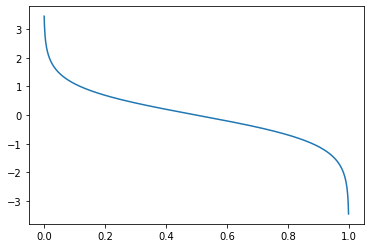Adaboost:原理及python实现
Table of Contents
Adaboost概述
Boosting提升方法是集成学习的另一种策略。

Adaboost的整体流程如上图所示。首先,训练一个弱学习器,其样本权重是相同的,根据训练结果,对样本的权重重新赋值,对于分类错误的样本提高其样本权重,然后使用更新后的样本训练第二个学习器,一直重复直到结束。最后,使用结合策略将几个弱学习器结合起来,形成最终的模型
Adaboost的核心思想就是,对于错误样本,赋予更高的权重,使模型更关注错误样本。对于错误率高的学习器,结合时候,给与更低的权重,使更准确的学习器有更多的话语权。
分类
算法流程
上一节大致讲了Adaboost的算法思路,但是有几个问题需要详细解决:
- 如何获取更新权重系数\(\alpha\)来更新样本权重
- 使用什么方法获得强学习器
Adaboost算法
输入:训练集\(T=\{(x_1,y_1),(x_2,y_2),...,(x_m,y_m),y\in\{1,-1\}\)
输出:最终分类器\(G(x)\)
- 初始化样本权重
- 对于\(k = 1,2,3,...,K\)
- 使用权重系数为\(D_k\)的样本集学习,获得弱分类器\(G_k(x)\)
- 计算分类器错误率e
其中
- 计算分类器权重\(\alpha_k\)
这个权重函数的图像如下所示,随着错误率增加,权重不断降低。当分类错误率为50%,也就是说这个分类器是随机分类时,该分类器的权重就是0。
import numpy as np
import pandas as pd
import matplotlib.pyplot as plt
import warnings
warnings.filterwarnings('ignore')
x = np.linspace(0,1,1000,endpoint=False)
y = 0.5 * np.log((1-x)/x)
plt.plot(x,y)
plt.show()

- 计算下一轮样本权重
或者也可以写为
其中
可以看出,每次跟新权重后,权重和仍然为1,由于通常情况下,\(\alpha_k>0\),所以,当分类错误时,样本的权重增加。
- 构建基分类器的组合
得到最终分类器
Adaboost的前向分步算法解释
Adaboost使用加法模型
优化问题可表示为
通常这是一个复杂的优化算法,前向分步算法的思想是:对于加法模型,每次只优化一个基分类器,然后逐步逼近目标函数。具体的,每次只优化以下函数:
Adaboost使用指数损失函数:
第k轮的优化就是
显然,使用的基分类器\(G_k(x)\)是错误率最低的分类器即为最优,因此,只需要优化分类器权重\(\alpha_k\)。同上,损失函数可以拆分为\(G_k(x)\)为{1,-1}的两部分:
由于
故
将错误率
代入上式得
对于权重
跟前面得更新权重只差了一个\(Z_{k-1}\),对于每一轮更新\(Z_{k-1}\)是常数,因此是等价的。
python实现
这里使用sklearn的DecisionTreeClassifier为基模型,实现了Adaboost算法,可以看出,与Sklearn实现准确率相近。
import numpy as np
from sklearn.tree import DecisionTreeClassifier
from sklearn.datasets import make_classification
from sklearn.ensemble import AdaBoostClassifier as ADASklern
class AdaboostClassifier:
def __init__(self, X, y, n_estimator=100):
self.X = np.array(X)
self.y = np.array(y).reshape(-1, 1)
self.y[self.y == 0] = -1
self.n_estimator = n_estimator
self.estimators = []
self.estimator_weights = np.ones(self.n_estimator)
self.estimator_errors = np.zeros(self.n_estimator)
self.sample_weights = np.ones(self.X.shape[0]) / self.X.shape[0]
def fit(self):
for i_estimator in range(self.n_estimator):
base_estimator = DecisionTreeClassifier(max_depth=1).fit(
self.X, self.y, self.sample_weights)
self.estimators.append(base_estimator)
y_pre = base_estimator.predict(self.X)
error_rate = sum(self.sample_weights * \
(np.ravel(y_pre) != np.ravel(self.y)).astype(int)) / self.sample_weights.sum()
estimator_weight = 0.5 * np.log((1 - error_rate) / error_rate)
self.estimator_errors[i_estimator] = error_rate
self.estimator_weights[i_estimator] = estimator_weight
self.sample_weights = self.sample_weights * \
np.exp(- estimator_weight * np.ravel(y_pre) * np.ravel(self.y)) / self.sample_weights.sum()
# def predict_vec(self, vec):
# predict_vec = [i.predict(vec.reshape()) for i in self.estimators]
# value = sum(predict_vec * self.estimator_weights)
# if value > 0:
# return 1
# else:
# return -1
def predict(self, X):
result_matrix = np.array([i.predict(X) for i in self.estimators]).T
result_vec = (result_matrix * self.estimator_weights).sum(axis=1)
return np.where(result_vec >= 0, 1, -1)
# if len(X.shape) == 1:
# return self.predict_vec(X)
# else:
# return_ = np.zeros(X.shape[0])
# for i in range(len(X)):
# return_[i] = self.predict_vec(X[i])
def score(self, y_true, y_pre):
return (y_true.ravel() == y_pre.ravel()).sum() / len(y_true)
if __name__ == '__main__':
X, y = make_classification(n_samples=1000, n_features=4,
n_informative=2, n_redundant=0,
random_state=0, shuffle=False)
ada = AdaboostClassifier(X, y)
ada.fit()
ada_sklearn = ADASklern().fit(X, y)
print(f"本例准确率:{ada.score(ada.y, ada.predict(X))}")
print(f"sklearn准确率:{ada_sklearn.score(X,y)}")
本例准确率:0.96
sklearn准确率:0.975
回归
回归与分类的流程类似,主要有以下几个区别
- 错误率e
回归的错误率首先计算预测值与实际值的偏差,然后归一化,然后有三种处理方式,分别是线性误差、平方误差和指数误差:
- 模型权重\(\alpha\)
- 样本权重
- 结合策略
其中\(g(x)\)是\(\alpha_kh_k(x)\)的中位数
sklearn中使用的是按权重加权平均。



 浙公网安备 33010602011771号
浙公网安备 33010602011771号